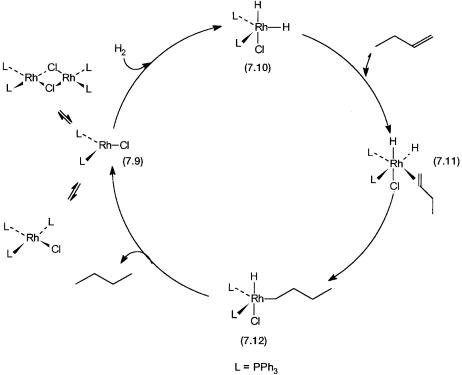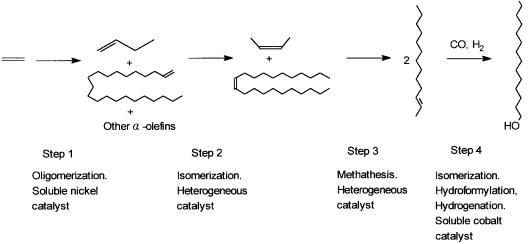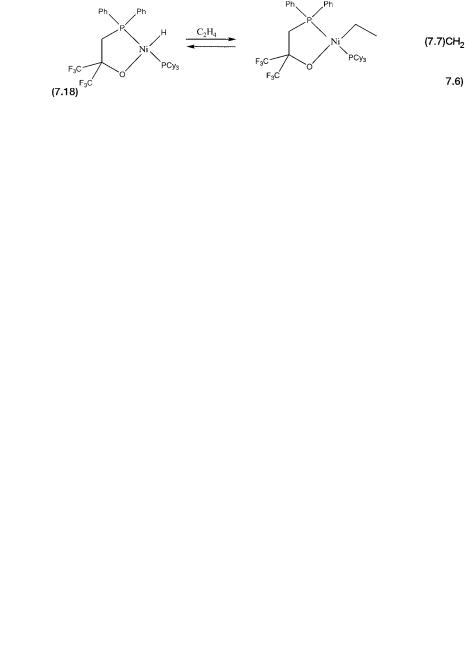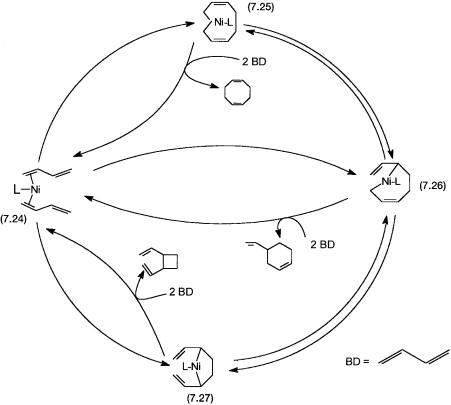
Homogeneous Catalysis
.pdf
136 OTHER ALKENE-BASED HOMOGENEOUS CATALYTIC REACTIONS
In the following section, we discuss the basic mechanism of homogeneous hydrogenation by Wilkinson’s catalyst, RhCl(PPh3)3. Many other complexes of rhodium as well as complexes of other metals such as ruthenium, platinum, lutetium, etc. have also been used as homogeneous, laboratory-scale, hydrogenation catalysts. The mechanisms in all these cases may differ substantially.
7.3.1Catalytic Cycle
The basic mechanism of hydrogenation is shown by the catalytic cycle in Fig. 7.3. This cycle is simplified, and some reactions are not shown. Intermediate 7.9 is a 14-electron complex (see Section 2.1). Phosphine dissociation of Wilkinson’s complex leads to its formation. Conversion of 7.9 to 7.10 is a simple oxidative addition of H2 to the former. Coordination by the alkene, for example, 1-butene, generates 7.11. Subsequent insertion of the alkene into the metal– hydrogen bond gives the metal alkyl species 7.12. The latter undergoes reductive elimination of butane and regenerates 7.9.
Figure 7.3 Hydrogenation by Wilkinson’s catalyst. For butene, oxidative addition of H2 precedes alkene coordination but not necessarily for all other alkenes.

HYDROGENATION OF ALKENES |
137 |
Note that although the conversion of 7.11 to 7.12 assumes anti-Markovnikov addition, the Markovnikov product also gives butane. Conversion of 7.9 to 7.11 could also take place by prior coordination of alkene followed by the oxidative addition of dihydrogen. Indeed this parallel pathway for the formation of 7.11 does operate. Like the equilibrium shown between RhClL3, 7.9, and the dimer [RhClL2]2, there is an equilibrium between 7.9 and the alkene coordinated complex RhCl(alkene)L2.
7.3.2Mechanistic Evidence
Homogeneous hydrogenation by RhClL3 has many instructive points about the successful use of kinetic methods for the elucidation of mechanism. Under a wide range of conditions, the rate law is found to obey the empirical relationship as shown by 7.3. A little algebraic manipulation and rearrangement would show that if the other variables are kept constant, then rate is inversely proportional to the concentration of L. This, of course, is consistent with the generation of 7.9 from Wilkinson’s complex by phosphine dissociation. The rate law also shows saturation kinetics with respect to both dihydrogen and alkene concentrations (Section 2.5.1).
The physical significance of the rate law is that consumption of alkene occurs by two pathways. One involves a rapid pre-equilibrium between 7.9 and dihydrogen to give 7.10. This is followed by a reaction with the alkene that eventually leads to the formation of the alkane. The other involves a similar equilibrium between 7.9 and alkene to give an alkene complex. This alkene complex then reacts with dihydrogen. In Fig. 7.3 for simplicity only the forward reaction of the former equilibrium has been shown.
Although the mechanism shown in Fig. 7.3 broadly applies to a variety of alkenes, the details and the sequence of reactions could vary significantly. We will see that for the hydrogenation of -acetamidocinamic acid, the catalyst– alkene complex is formed first, which then oxidatively adds to dihydrogen. More precisely, out of the two equilibria, one with the alkene and the other with dihydrogen, which one would dominate is determined by the nature of the alkene. Even within the class of unfunctionalized alkenes there may be significant differences between the types of catalytic intermediates that are involved.
Reaction of 7.9 with dihydrogen has been studied by NMR spectroscopy. Two isomers of 7.10, one as shown in Fig. 7.3 and the other where the two Ls are trans and occupy axial positions (Complex 7.13 in Fig. 7.4), have been

138 OTHER ALKENE-BASED HOMOGENEOUS CATALYTIC REACTIONS
Figure 7.4 Catalytic cycle assumed for the ab initio theoretical calculations of alkene hydrogenation. Note that structure 7.10 is different from 7.13, and in solution these are in rapid equilibrium.
observed. The energy required for the interconversion between these two isomers is of course small. As we have seen earlier (Sections 2.3.3 and 2.5.3) both insertion and reductive elimination have been well studied in model systems.
Ab initio quantum-mechanical calculations have also been carried out to estimate theoretically the relative energies of different transition states and intermediates. To keep the calculations at a manageable level the model catalytic cycle shown in Fig. 7.4 has been considered. According to this calculation, conversion of 7.14 to 7.15 is found to be the rate-determining step. This is consistent with the empirical kinetic results. Isomerization of 7.15 to 7.16 is found to be thermodynamically highly favorable. The reductive elimination step, that is, 7.16 to 7.7, is found to have a very low free energy of activation and be thermoneutral, that is, thermodynamically neither strongly favorable nor unfavorable.
7.4OLIGOMERIZATION OF ETHYLENE
Oligomerization of ethylene to give linear terminal alkenes or the so-called - olefins is a very important industrial reaction. The linear -olefins with 10 to

OLIGOMERIZATION OF ETHYLENE |
139 |
18 carbon atoms are important feed stock for a variety of detergents. Oligomers with 4–10 carbon atoms find uses as co-monomers in the manufacture of polyethylene and also as starting materials for the manufacture of plasticizer alcohols by the hydroformylation reaction.
Industrial processes utilize aluminum or nickel complexes as catalysts for oligomerization. Both Gulf Oil and Ethyl Corporation use aluminum alkyls, while the Shell higher olefin process (SHOP) involves the use of a nickel catalyst. Both these basic reactions (i.e., oligomerization of ethylene by aluminum alkyl, “Aufbaurektion,” and the fact that in the presence of nickel such an oligomerization reaction yields mainly butene (the “nickel effect”), were discovered by Ziegler in the early 1950s. The mechanism of oligomerization is basically the same as that of ethylene polymerization (see Section 6.4.1). However, in this case chain termination by -elimination has to occur far more frequently to keep the chain length down.
Stoichiometric reaction of the type shown by 7.4 also leads to the formation of ethylene oligomers. In the Ethyl Corporation process one step involves stoichiometric reaction of this type. Another variant of this is the Conco process, where such stoichiometric reactions are followed by oxidation and hydrolysis of the aluminum alkyls. This gives linear -alcohols that are used in biodegradable detergents. The co-product is highly pure alumina, which has a variety of uses, including that of an acidic heterogeneous catalyst.
7.4.1Shell Higher Olefin Process
SHOP involves essentially four sequential operations. First ethylene is oligomerized with a soluble nickel catalyst to give linear -alkenes. In the second step, over a heterogeneous catalyst these are isomerized to internal alkenes. In the third step internal alkenes containing four to eight carbon atoms are mixed with internal alkenes of 20 and more carbon atoms and the mixture is subjected to the metathesis reaction (see Section 7.6). In the fourth step three reactions
—isomerization, hydroformylation, and hydrogenation—are simultaneously carried out with a homogeneous cobalt catalyst to give long-chain -alcohols. The reactions of the fourth step were discussed in Chapter 5 (see Table 5.1 and Section 5.3). The sequence of reactions is schematically shown in Fig. 7.5. In this section, we discuss only the first step, the oligomerization of ethylene to give linear -olefins by soluble nickel catalysts.
As already mentioned, the mechanism of oligomerization is the same as discussed for polymerization, and a catalytic cycle similar to the one shown in Fig. 6.3 operates. Many nickel–phosphine complexes have been successfully used as the precatalysts; 7.17 is one such example. As shown by 7.5, reaction of a phosphorous ylide with a suitable nickel-containing precursor makes this

140
Figure 7.5 The four steps of Shell’s higher olefin process (SHOP). Fourand 22-carbon-atom alkenes are taken as representative examples.

OLIGOMERIZATION OF ETHYLENE |
141 |
complex. The selectivity of the oligomerization reaction is largely controlled by the chelating ligand.
Under the reaction conditions the precursor complex probably generates a nickel–hydride species, which then initiates the oligomerization reaction. Evidence for this comes from the studies on the reactions of 7.17. As shown by 7.6, on reaction with ethylene 7.17 eliminates styrene and produces a nickel– hydride complex. A model catalytic intermediate 7.18 has been characterized by single-crystal X-ray studies. Complex 7.18 reacts with ethylene to give a nickel–ethyl species in a reversible manner. This is shown by reaction 7.7. Reactions 7.6 and 7.7 are strong evidence for the involvement of a nickel– hydride catalytic intermediate.
142 OTHER ALKENE-BASED HOMOGENEOUS CATALYTIC REACTIONS
7.5DI-, TRI-, AND CODIMERIZATION REACTIONS
One of the industrially important dimerization reactions that involves the use of homogeneous catalysts is the dimerization of propylene. Dimerization of propylene produces mixtures of the isomers of methyl pentenes, hexenes, and 2,3-dimethyl butene and is practiced by the Institut Francis du Petrole (IFP), Sumitomo, and British Petroleum (BP). The methyl pentenes and hexenes are used as gasoline additives. Dimethylbutene is used in the fragrance and the agrochemical industries.
Dimerization of butadiene is used for the selective formation of 1,5-cyclo- octadiene (1,5-COD), which on selective hydrogenation gives cyclooctene. By ring-opened metathesis polymerization of cyclooctene a specialty polymer is obtained (see Section 7.6.1). Hulls sells this polymer as Vestenamer .
Butadiene could also be trimerized to give cyclododecatriene. The trimer is again used by Hulls to manufacture nylon 12 and Vestamid . The codimerization of butadiene and ethylene is used by DuPont to manufacture 1,4- hexadiene, one of the monomers of EPDM (ethylene, propylene, diene, monomers) rubber. The role of the diene monomer in EPDM rubber is to provide with two double bonds of different reactivities. The more reactive, terminal double bond takes part in the polymerization with ethylene and propylene. The less reactive internal one is used later on for cross-linking. These important catalytic reactions are shown in Fig. 7.6.
7.5.1Dimerization of Propylene
The dimerization of propylene carried out by IFP is called the DIMEROSOL process and involves the use of nickel catalysts. This is shown in Fig. 7.7. Complexes 7.20 and 7.21 are the anti-Markovnikov and Markovnikov insertion products into the Ni–H bond. Structures 7.23(A) and (B) are intermediates derived from 7.21 by inserting the second propylene molecule in a Markovnikov and anti-Markovnikov manner, respectively. Similarly 7.22(A) and (B) are intermediates from 7.20 by the insertion of the second propylene molecule. These four nickel–alkyl intermediates by -elimination give six alkenes. Under the process conditions these alkenes may undergo further isomerization.
7.5.2Diand Trimerization of Butadiene
Both diand trimerization of butadiene with soluble nickel catalysts are wellestablished homogeneous catalytic reactions. The precatalyst having nickel in the zero oxidation state may be generated in many ways. Reduction of a Ni2 salt or a coordination complex such as Ni(acac)2 (acac = acetylacetonate) with alkyl aluminum reagent in the presence of butadiene and a suitable tertiary phosphine is the preferred method. The nature of the phosphine ligand plays an important role in determining both the activity and selectivity of the catalytic

Figure 7.6 Industrial use of (from the top): propylene dimerization, butadiene dimerization, butadiene trimerization, and butadiene plus ethylene codimerization. In EPDM rubber, the terminal double bond of 1,4-hexadiene takes part in polymer formation. The internal double bond is used during curing.
143

144
Figure 7.7 Catalytic cycles for propylene dimerization. For the first propylene molecule the left and right cycles represent the anti-Markovnikov and Markovnikov pathways, respectively. Note that for 7.22(A) and 7.23(A) there are two -hydride positions.

DI-, TRI-, AND CODIMERIZATION REACTIONS |
145 |
system. The other products that may be formed in this reaction are vinylcyclohexene and divinylcyclobutane. By an optimal choice of ligand and reaction conditions, formation of these by-products may be avoided to a large extent, and 1,5-cyclooctadiene may be obtained with >96% selectivity.
The catalytic cycle proposed for the dimerization of butadiene is shown in Fig. 7.8. As shown by 7.24, two molecules of butadiene coordinate to NiL. A formal oxidative addition, as shown by Eq. 7.8, produces two nickel–carbon bonds and the carbon–carbon bond required for ring formation. The structure of 7.25 with two nickel–carbon bonds (see Fig. 7.8), is a hypothetical one that helps us to understand the carbon–carbon bond formation process. The actual catalytic intermediates that have been observed by spectroscopy have an 3- allyl type of bonding. As shown by reaction 7.9, species 7.25 can reductively eliminate 1,5-cyclooctadiene and the zerovalent nickel complex Ni–L.
Figure 7.8 Dimerization of butadiene. L is a phosphine or phosphite (see Problem 11). 7.26 and 7.27 can be formed from butadiene (BD) and L–Ni by 7.8-type formalism.
